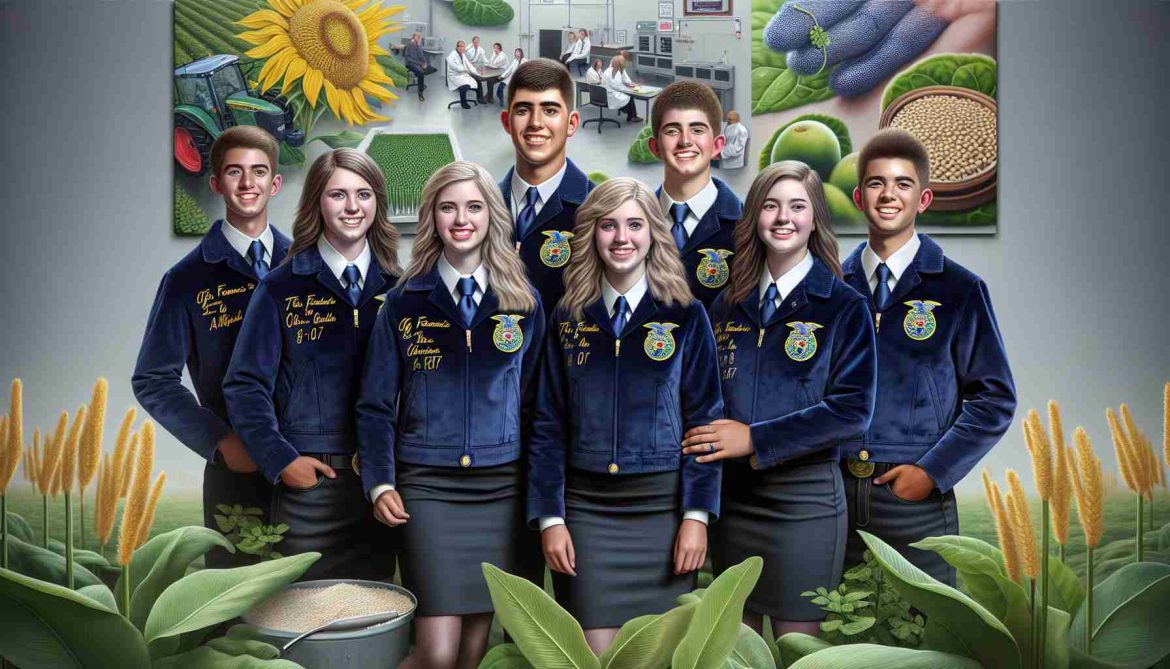- Paulding High School’s FFA Agriculture Biotechnology team achieved 9th place in a state contest at the Ohio Department of Agriculture.
- The team, consisting of Jacob Harris, Remington Boroff, Grace Goyings, and Luke Beckman, advanced through a challenging online exam.
- Participants demonstrated skills in biotechnology, focusing on bird flu research and presenting their findings to judges.
- The team’s proficiency in laboratory techniques earned them a place at the Ohio FFA state convention in May.
- Mentor Mr. Gilbert played a significant role in guiding and preparing the students for the competition.
- Their passion for scientific exploration highlights the potential for innovation in agricultural biotechnology.
- The team is eager to build on their experience for future competitions, emphasizing dedication and perseverance.
Four determined minds from Paulding High School embarked on a remarkable journey this January, transforming a simple agricultural science competition into a stage for youthful ingenuity and diligence. The Paulding FFA’s Agriculture Biotechnology team showed their mettle at the Ohio Department of Agriculture in Reynoldsburg, seizing a commendable 9th place in the state contest.
The young contenders—Jacob Harris, Remington Boroff, Grace Goyings, and Luke Beckman—stepped into the spotlight after securing their place in the top 20 via a rigorous online examination. Armed with sharpened laboratory skills and a well-honed ability to identify diverse biotechnology, they tackled the state challenge head-on. Picture them intently focused under sterile fluorescent lights, wrestling with the complexities of bird flu through research and analysis, all culminating in a persuasive presentation aimed at seasoned judges.
From deftly handling micropipettes to gracefully maneuvering lab equipment, the quartet demonstrated expertise that would earn them a spot on the podium at the Ohio FFA state convention in May. Their guided training, enriched with the insights from Mr. Gilbert, their mentor, clearly reaped rewards.
These students reminded everyone that passion for scientific exploration doesn’t solely live within lab-coated professionals. They embodied a profound and infectious enthusiasm for learning that hints at a bright future for agricultural biotechnology. Paulding’s team is already setting sights on next year’s competition, armed with invaluable experience and unyielding perseverance.
Such stories inspire, underscoring a truth widely acknowledged: the seeds of tomorrow’s innovations may very well be planted in today’s classrooms.
Unlocking the Secrets to Success in Agricultural Biotechnology Competitions
How-To Steps for Excelling in Agricultural Biotechnology Competitions
1. Master the Basics of Biotechnology: It is pivotal to understand fundamental biotechnology principles. Dive into topics like genetic engineering, CRISPR technology, and microbiome analysis. Reliable sources such as NIH can provide comprehensive materials for further learning.
2. Develop Practical Laboratory Skills: Hands-on experience with tools such as micropipettes and spectrophotometers is essential. Consider enrolling in workshops or online courses that provide interactive laboratory simulations.
3. Engage in Team Collaboration: Operating as a cohesive unit can significantly enhance performance. Regular team meetings to discuss strategies, divide tasks, and peer-review work can boost efficiency and morale.
4. Participate in Mock Competitions: Prior exposure to competitive environments helps in acclimating to real challenges. Organize school-level contests or join community science fairs for practice.
5. Seek Mentorship: Guidance from experienced educators like Mr. Gilbert is invaluable. Establish a network with teachers or professionals in the field to gain insights and constructive feedback.
Real-World Use Cases of Biotechnology in Agriculture
Biotechnology is transforming agriculture by enabling:
– Crop Improvement: Genetically modified crops that are resistant to pests, diseases, and harsh environmental conditions ensure better yields.
– Biofortification: Enhancing the nutritional quality of food crops ensures that populations receive essential nutrients.
– Sustainable Practices: Biopesticides and biofertilizers reduce reliance on chemical alternatives, promoting environmental sustainability.
Market Forecasts & Industry Trends
According to a report by Grand View Research, the global agricultural biotechnology market is expected to reach USD 73.99 billion by 2025. Growing demand for high-yield crops and advancements in genetic engineering are key drivers of this market.
Pros & Cons Overview
Pros:
– Provides solutions to global food security challenges.
– Reduces agricultural chemical usage.
– Enhances crop resilience to climate change.
Cons:
– Public concerns over GMO safety and environmental impact.
– Ethical debates on genetic manipulation and biodiversity loss.
Actionable Recommendations
– Stay Updated: Regularly follow scientific journals and news related to biotechnology advancements.
– Experiment Safely: Always adhere to safety standards and protocols in laboratory settings.
– Network with Peers: Engage in regional and national science competitions to build connections and share knowledge.
Embrace the interdisciplinary nature of biotechnology, blending biology with technology to tackle agricultural challenges. Students like those from Paulding High School prove that dedication and proper mentorship can lead to extraordinary achievements.



